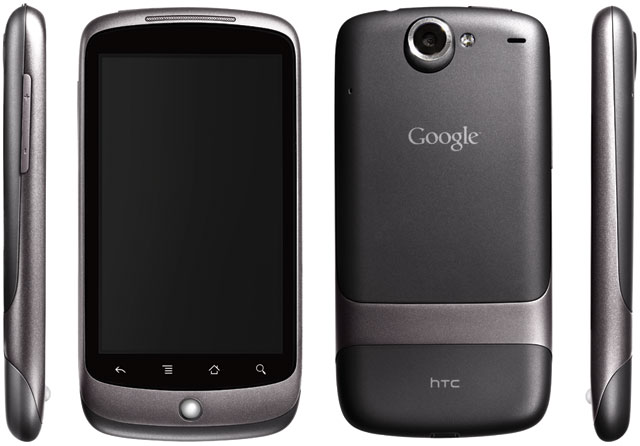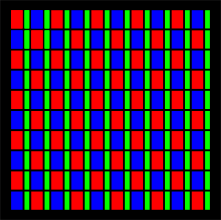
In two recent comparisons of the Nexus One's famed AMOLED screen to the iPhone's LCD screen, one done by a display testing company and another done by a blogger, the Google phone's display actually came out the loser. Most of the online debate that followed the two articles was centered around color accuracy, color quantization artifacts, viewing angle, etc., with Google's defenders arguing that the numbers don't tell the full story because you have to take human perception and the human visual system into account, among other factors. But a related, and potentially even bigger issue, hasn't been investigated as thoroughly as the others. Specifically, despite the fact that both Google and HTC have repeatedly claimed that the Nexus One's display is 480x800 pixels in size (252 pixels per inch), the actual effective screen resolution may be substantially less than that, depending on how you count the pixels.
Sorting out the real resolution of the Nexus One's screen is much more than a minor technical exercise, because a lot of Nexus One buyers (myself included) based their purchasing decision at least in part on the amazing-sounding screen resolution, and many of us were disappointed in the lack of crispness of text. It's also worth noting that the next-generation iPhone is rumored to use the same AMOLED technology as the Nexus One, and AMOLED will become the standard on many or most high-end Android phones in the near future—will all of these upcoming AMOLEDs take this same shortcut with their resolution?
In this article, I'll explore the issue of the Nexus One's screen resolution in some detail. I'll also talk a bit about the science behind how the screen works, and I'll show you some cool image hacks that let you turn greyscale images into color, just by using pinch-and-zoom in the Nexus One's gallery application.
Note: We offered a Google a chance to comment on the issues raised in this article, but we received no reply as of press time.
The PenTile matrix
The screen on the Nexus One is one of the features I was most looking forward to. The Nexus One is one of the first mainstream devices to employ AMOLED display technology, which is supposed to be more vivid, have better contrast, and draw less power than most LCD screens. However, the very first thing I noticed after switching on my new N1 was that the pixels looked swizzled somehow, resulting in fuzzy, dithered-looking edges at hard intensity transitions, especially when reading black-and-white text. Even areas of solid color looked like they were dithered with a regular pattern. A similar swizzling effect was present on the original OLPC XO's screen in color mode.
Subjectively comparing the Nexus One's display next to the Motorola Droid's display, it became even more obvious that, though the display resolutions are claimed to be almost identical (480x800 on the Nexus One vs. 480x854 on the Droid), text on the Droid's display looks significantly sharper than on the N1's display. The Nexus One display just doesn't look like it has the stated resolution.
A close look at the N1's display under magnification reveals what's really going on.

You can see from the photo above that each logical pixel on the Nexus One screen contains one green subpixel and either one double-width blue subpixel or one double-width red subpixel. So the red and blue color channels on the Nexus One display each have half as many subpixels (480*800/2) as the green channel. Basically, half the red and half the blue spatial information in the 2D image being sent to the display is simply thrown away or spread to the nearest matching subpixel by a convolution or intensity-dispersion process.
Not only is image information being discarded, but to put a specific RGB color on the screen, at least two physical RG and BG pixels must always be addressed—more likely four pixels for symmetry between the axes. It's difficult to believe the stated resolution of the display if not every pixel contains every color channel, because pixels are normally counted in RGB triplets.
The peculiar arrangement of subpixels on the N1 display is known as the PenTile matrix, developed by Nouvoyance (formerly Clairvoyante), and acquired by Samsung in March 2008. The PenTile layout comes in an RGBW flavor that adds a white pixel for increasing "aperture ratio and transmissivity" on LCD screens as well as the RGBG layout used in the Nexus One's OLED screens.

There are numerous reasons that Nouvoyance gives on their website for why this subpixel layout is a good idea. One benefit of the double-sized red and blue subpixels is that it supposedly increases the life of the blue subpixels, which are prone to have much shorter lives than red or green at smaller sizes. I don't know for sure if pixel lifetime is related to pixel size, but there are numerous reports of dead and stuck pixels on Nexus One screens all over the Web, and my own phone developed a dead pixel after I had had it for a week.
Pixel lifetime aside, the screen layout can't solely be a cost-saving measure, because patent licenses have to be paid for PenTile. And the layout can't logically be argued to be a limitation in manufacturing capability, because it is clear that the screen manufacturing process is able to create full-resolution green subpixels that are one-third the size of a physical pixel.
Overall, it is hard to see any really good advantages to the PenTile layout, yet there are some big downsides in reducing spatial resolution of two of the color channels.
reader comments
168